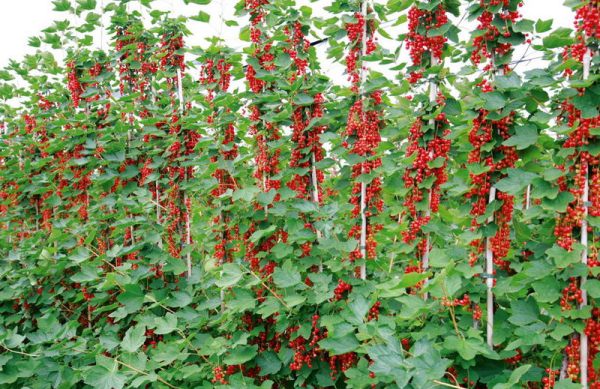The function of the modern garden includes not only providing crops, but also giving the site a decorative, aesthetic look. Many gardeners are looking for solutions to combine business with pleasure. One of the worthy options is growing berry bushes and hazel groves on a trunk.. This technique allows you to use dogwood, hazelnuts, chokeberry and even prickly gooseberries in landscape design. Separate conversation deserves shtambovaya currants.
Table of contents
What is standard currant?
In form it is no longer a shrub, but a mini-tree. It has one central conductor, from the top of which several side branches extend.
Hungarian gardeners first guessed to grow berry crops in such an unusual way. True, this invention was not born by aesthetic needs, but by severe necessity. Wet and hot weather in the summer months was the reason for the spoiling of a large number of berries: located close to the ground, they simply threw out.
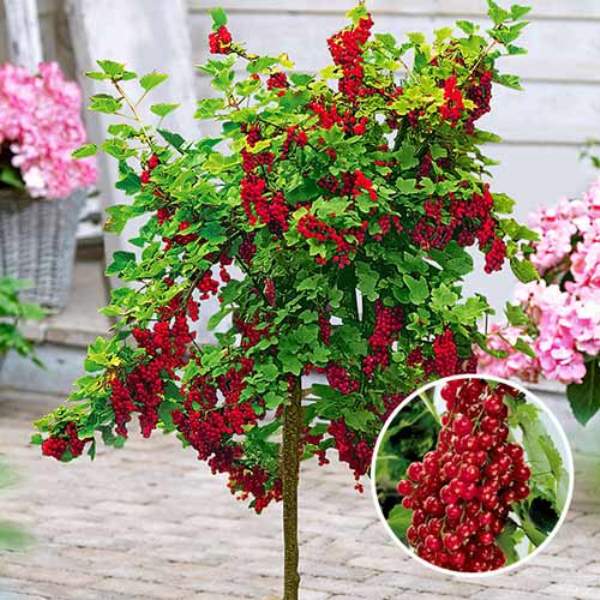
In the old pre-revolutionary Russian gardens there were also stab berries. For a long time only individual enthusiasts used this method, but now the technique is gradually becoming fashionable again. Especially, There are many advantages of stab cultivation:
- fruiting shoots and berry brushes do not fall on the ground, which reduces the percentage of damage;
- currant less exposed pest attack;
- the crown is well and evenly litthat improves yield formation;
- fruit picking and caring for a plant is much easier;
- it is possible to do more compact landings and save plot area;
- easier care behind pristvolny circle;
- standard currant decoration on the order surpasses the bush forms.
Of course, as in any serious matter, it is not without its drawbacks:
- standard shapes less hardy;
- strong winds can break a tree.
And yet with the skillful approach, any shortcomings can be reduced to zero.
Landing features
Acquired seedling shtambovoy currants can be planted in autumn and spring. The specific period must be selected based on the nature of the climatic zone. In regions where there is a lot of snow in winter, autumn planting is good. The snow cover will protect the immature plant from freezing. If winters are not snowy, it is better to plant currants in spring, after thawing of the soil.
The landing pit for standard currants is prepared standard - 0.5m * 0.5m * 0.5m. Filled with compost or humus and two glasses of ash. A strong high support is driven into the bottom of the landing pit.
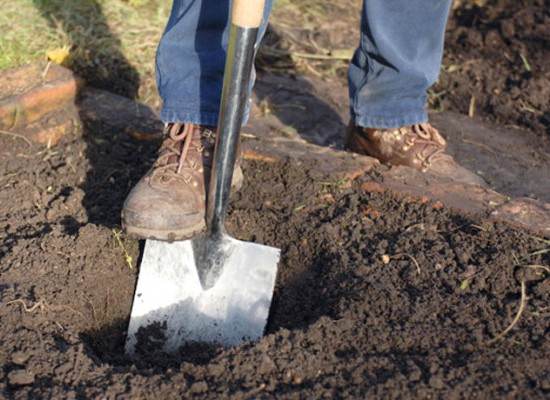
When planting standard currant there is an important nuance. In contrast to the bush, its seedling is not placed in a pit under an inclination, but set straight up. The plant is securely fixed to the support. Roots straighten and bury a hole, after which the seedling is watered well.
How to grow currants on the trunk with your own hands?
Standard currant seedlings do not have to buy. To form such a plant yourself with your own hands is a snap.
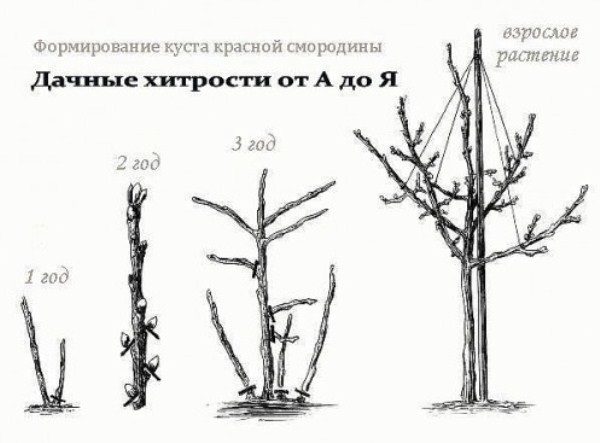
In practice, there are two ways of growing:
- on a stock;
- Korn own shtambom.
The first method is relatively modern. The second is the old one that was used by gardeners over a hundred years ago.
Growing on root stump
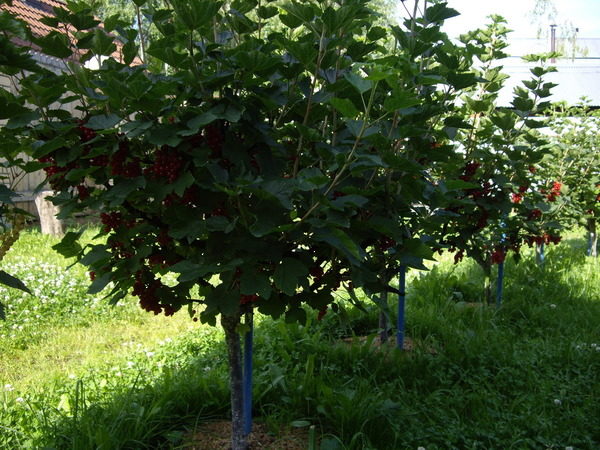
This method can be used to form a sapling of any red, black or golden currant variety purchased in the nursery or existing on the site.
- In early spring, before the start of sap flow On the plant, choose one well-developed upright shoot length from 80 cm before 1m. The rest is cut off at the root.
- On the left escape pinch the top.
- Stepping back to 3-4 buds, blind the underlying over the entire length of the conductor.
- When the lateral shoots from the upper buds follow, pinch over 3-5 sheets.
- In the second year repeat the pinning on growing shoots.
- Beginning from the third year perform only thinning and sanitary pruning as needed.
Throughout the life of the plant, it will be necessary to look after the bole and remove from it all the emerging shoots.
Growing stock
This method today is the most frequently used in European nurseries. But in order to grow shtambovy currants in this way, you need to master the art of "garden surgery". If possible, on a stock they buy a sapling or stalk golden currant Breht corona. If not, you can try using your own plants.
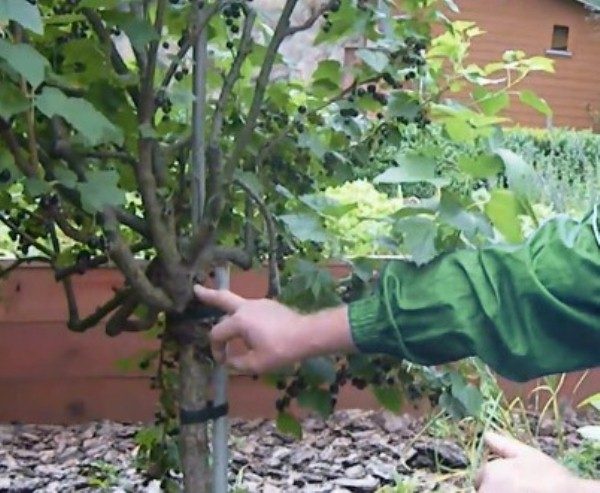
- From rooted cuttings or layering grow stock material, initially expelling the plant into one vertical shoot. All lateral branches appearing on the future trunk will be removed to make the trunk more likely to thicken. The stock is considered ready to work when it length will reach 80 cm, but top thickness - 4-5 mm.
- Hand graft take the stalk of any sort you like. It is better to choose winter-hardy, disease-resistant, with beautiful long tassels. Scion Length - 3-4 buds.
- Perform vaccination in shtamb method of improved copulation.
- On the trunk blind all the kidneys.
- When the side shoots growing on the graft reach a length of 10-15 cm, they are pinned above the 3rd leaf. Giving them to grow stronger can not be: there is a large sail, and the plant may break off at the site of vaccination.
- The following year, in the same way, pinch new side shoots.
- From the third year after vaccination - pruning sanitary and thinning.
After grafting, the shtamb again and again will try to start up lateral growth. This should be monitored and in time to remove excess.
Care for standard currants
The life span of a standard currant form is longer than a bush one. "Berry on a stick" can successfully bear fruit to 15-18 years old. A complex of agrotechnical measures is necessary to ensure harvests.
| Watering | It is impossible to allow both drying and remoistening of the soil. Watering is necessary by necessity, ensuring the penetration of moisture to a depth of at least 1 meter.
In the autumn, especially in dry years, it is useful to make water recharge irrigation to increase currant winter hardiness. |
|---|---|
| Feedings | Spring: nitrogen fertilizers (manure, compost). Be careful with urea - standard forms cannot be overfed with nitrogen.
Summer: manure - 5 kg, potassium sulphate - 10 g, superphosphate - 40 g. Autumn: superphosphate - 50 g, potassium sulphate - 20 g |
| Pruning | Starting from the 4th year of life, rejuvenating pruning is performed. All the old shoots, on which fruiting has ceased, are annually removed from the plant. The shape of the crown support by cutting thickening shoots. Bottom shoots are regularly removed. |
| Shelter for the winter | To prevent frosting of branches (especially in black currants) for the winter, standard currants can be wrapped in a cover of 2-3 layers of agrospan. |
Another important manipulation that is required when caring for the standard currant is the garter. Branches loaded with a crop may break off. One of the best ways to prevent a catastrophe is to build an umbrella chatalovka.. This design resembles a carousel:
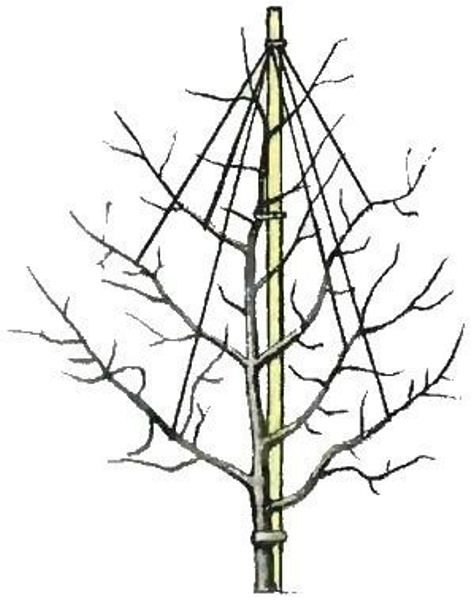
- to the wooden support to which the stem is tied, screw up screwed on top;
- to screw tie a few pieces of twine (by the number of branches);
- the ends of the twine are tied around the branches and a little pull up.
Thus, the branches with the harvest are in limbo and do not break off.
Conclusion
Growing currants on shtambe - creative lesson. Showing imagination, you can create on your site avenues or labyrinths of mini-berry trees, at the same time freeing up space for flowers and lawn. A rich harvests, which brings standard currant, will be at the same time an additional bonus.
